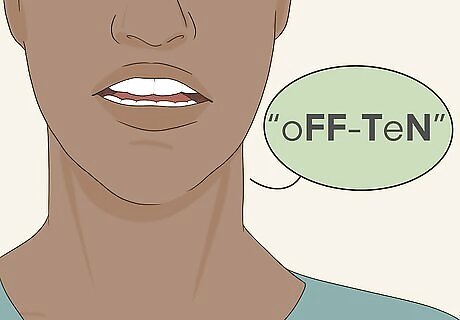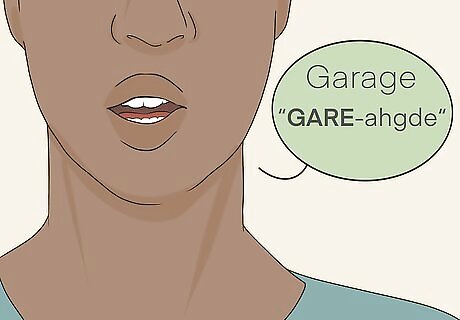
views
Mastering Mouth Movements

Speak through your hands to help your mouth move vertically. Hold your hands parallel to one another on either side of your mouth. Then, imagine you are speaking through a crack in the wall. Make sure that your mouth never widens past your hands. Your lips will need to move up and down rather than to the sides, which is how British people tend to speak. For example, practice with the Shakespearean quote “O for a Muse of fire, that would ascent the brightest heaven of invention.” With an American accent, for example, the words “muse,” “would,” “brightest,” “heaven,” and “invention” are generally spoken with a relaxed mouth where lips move up and down and to the sides. With a British accent, however, these words are spoken with the lips moving only up and down.

Focus on keeping energy in your upper lip as you speak. Speaking with a British accent generally requires more facial engagement than many other accents, such as most American or Canadian accents. If you naturally speak with a more relaxed accent, it is likely that your upper lip relaxes as you speak. Focusing on engaging your upper lips as you speak will help you keep the correct shape in your mouth while you speak in a British accent. Practicing the word “hello” can be particularly helpful. With many accents, such as most American and Canadian accents, “hello” is spoken with little movement in the upper lip. To say “hello” with a British accent, however, the upper lip must be engaged and move upward as the “h” is spoken.

Practice flicking and twisting the tip of your tongue. Unlike most American and Canadian accents, which are generally spoken with a lazy tongue tip, most British dialects require that you have a flexible tongue tip. Flicking and twisting your tongue around will help you loosen the muscle and be able to perfect your pronunciation.

Watch British people speak to mimic the mouth movements. As babies, we first acquire our particular accents by watching our parents and the people around us move their mouths. You can use this same method to help you retrain your mouth to move in ways that will allow you to speak with a British accent. Watching dialect videos online can be particularly helpful. In these videos, accent experts often over-enunciate words and dramatize their mouth movements to help viewers mimic the movements more easily. YouTube, for example, has a vast amount of dialect videos. This can be particularly helpful if you are trying to learn a specific British dialect. For example, if you trying to learn a Scottish accent, focus on watching Scottish people speak. While there are consistencies, the mouth movements will vary from other British dialects, such as a Received Pronunciation English accent.
Learning the Pronunciation

Practice enunciating your consonants clearly. When learning a British accent, try to deliberately enunciate the consonants in words as you speak. Unlike many other accents, such as most American accents, most British dialects enunciate consonants very clearly. For example, the word “often” is pronounced “off-en” in an American accent. When spoken with a British accent, “often” is pronounced “oFF-TeN,” with all of the consonants clearly enunciated.

Enunciate your “t”s clearly. “T”s are particularly important for nailing a British accent. While Americans tend to gloss over the “t”s in words, British speakers clearly enunciate the “t”s. To practice, try speaking out repetitive ditties, such as “ten tiny typists tripped through the tunnel.” You will likely need to enunciate the “t”s in order to avoid tripping up. The word “British” is a great example. With a British accent, the word “British” is pronounced “BriT-Tish,” where the “t”s are clearly enunciated. In contrast, when spoken in an American accent, “British” is pronounced “Bri-dish.”

Go softer with your “r”s. Unlike many other accents, British people tend to slide over the “r”s in words as they speak. For example, the word “farther” is often pronounced as “father” would be for an American. When learning a British accent, try to soften your “r”s by keeping the back of your tongue down. When you are just beginning, “car” is an easy word to practice with. Instead of “car” with an enunciated “r”, try keeping your tongue down to pronounce the “r” more like “ah.”

Pronounce your “u”s with an “ew” sound. In contrast to an American accent, where “u”s are often pronounced like “oo,” speaking with a British accent requires that you pronounce “u”s with an “ew” sound. For example, when spoken in an American accent, the word “duty” is pronounced like “doo-ty.” In contrast, when spoken in a British accent, “duty” is pronounced “dew-ty.”

Stress syllables in a British manner. To learn a British accent, it is important that you learn when to stress syllables in different types of words. For example, when speaking with a British accent, the word “garage” is pronounced “GARE-ahdge,” where the first syllable in stressed. In contrast, when spoken in an American accent, the last syllable is stressed. “Garage,” then, is pronounced “ga-RAHJ” in an American accent.

Learn the different dialects. While there are pronunciation commonalities to all British accents, there are also a lot of differences depending on the country, region, city, and even neighborhood within a single city. To learn to speak with a British accent, determine if you specifically want to learn to an English accent, a Northern Irish accent, a Welsh accent, a Scottish accent, or one of the many other British dialects. For example, in England, the word “alright” is generally pronounced “al-right,” where both the “l” and the “t” are clearly enunciated. In Scotland, however, “alright” is generally pronounced as “aw-right” with a soft “l” that sounds as a “w” would sound in America.
Learning the Lingo and Vocabulary

Understand the uniquely-British usage of English-language words. In addition to pronunciation, using the correct vocabulary is necessary to convincingly speak with a British accent. While most English language words are used in the same manner across English-speaking places, there are some words that are used in ways specific to Great Britain and, within Great Britain, specific to different areas. Although the meaning of the words does not change, per say, the way they are used is generally unique to Britain. For example, in Great Britain, the Royal Mail delivers the post, whereas in America, the Post Office delivers the mail. While both “post” and “mail” relay similar meanings and can likely be understood either way, use the former to make your British accent more realistic.

Learn which English-language words have different meanings. While most English-language words have the same or similar meanings, there are some words that have a wholly different meaning for Brits. In order to nail your British accent, it is crucial that you learn what these words are, what their uniquely-British meanings are, and use them accordingly. For example, in America, “mad” generally equates to “angry.” In Great Britain, however, “mad” almost exclusively means “crazy.”

Use British conversational lingo to convincingly speak like a Brit. When learning a particular British dialect, it is important that you find out what the “slang” terms and phrases are. While these terms and phrases might not be a part of any formal accent training, learning the slang is crucial if you are going to have a convincing accent. For example, British people often use “rubbish” as slang for lying or not making sense. Similarly, “pull a sickie” is used to refer to taking a sick day from work.

















Comments
0 comment